Kathy Dia
Introduction
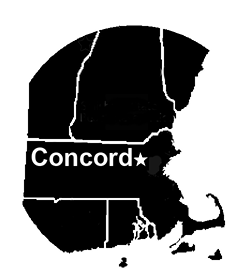 Minute Man National Historical Park (Minute Man NHP) spans almost 1000 acres in the towns of Lexington, Lincoln, and Concord. The park, managed by the National Park Service, was founded in 1959 to preserve and commemorate the site of the opening battles of the American Revolution, including that of Old North Bridge, where the first shots of the series of battles were fired in 1775.
Minute Man National Historical Park (Minute Man NHP) spans almost 1000 acres in the towns of Lexington, Lincoln, and Concord. The park, managed by the National Park Service, was founded in 1959 to preserve and commemorate the site of the opening battles of the American Revolution, including that of Old North Bridge, where the first shots of the series of battles were fired in 1775.
When you think of Minute Man NHP, wide narrated paths with strolling tourists may come first to mind. However, you may be surprised to learn that these only comprise a small portion of the park, which supports a variety of habitats. Forests comprise about 500 acres of the park, meadow and field 250 acres (about half of which is leased for farming), and non-forest wetland 180 acres. See Figure 1: Overview Map of Minute Man National Historic Park.
When my husband and I moved to Concord in 2006 we began strolling in the park in the evenings and quickly discovered how many under-appreciated birding nooks it held. In 2012 I began volunteering as a monitor for Vermont Center for Ecostudies' Landbird Survey, which takes place each June in eleven northeastern National Parks, including Minute Man NHP. Through this project I gained an appreciation of the park as an important corridor for nesting species.
In this article I will describe my three favorite birding routes, in order from the west (Concord) end of the park toward the east (Lexington) side. The routes are easily connected for a longer outing. The park currently has two eBird hot spots if you are listing (see the eBird section at the end of article). Minute Man is quite a large park, and I am certain that you will find seasonal hotspots and species that I have not yet found.
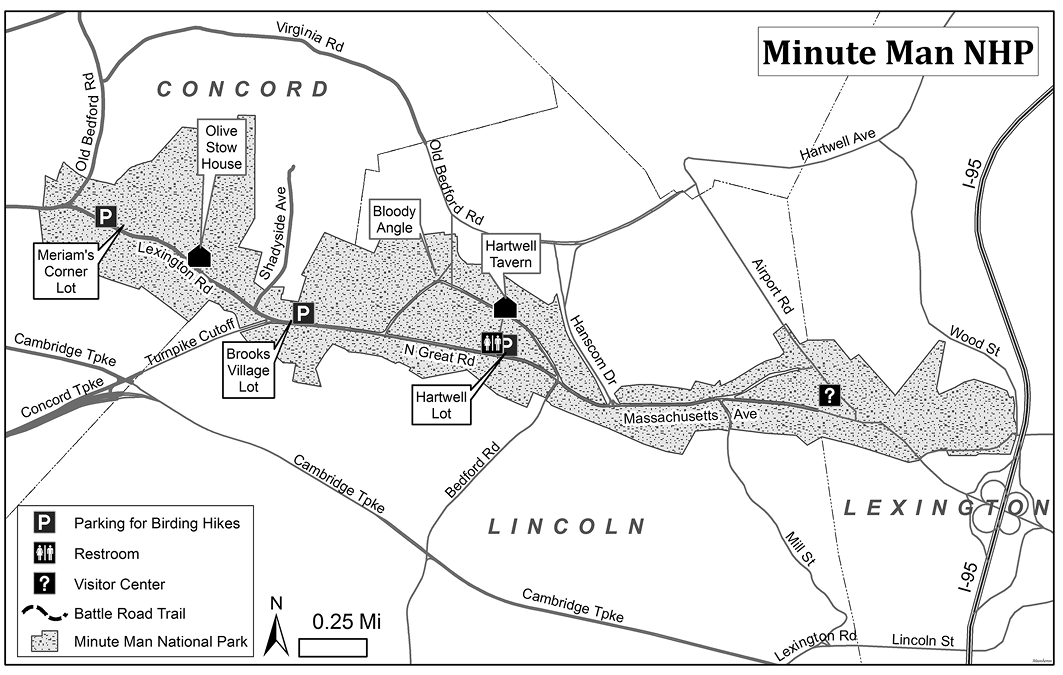
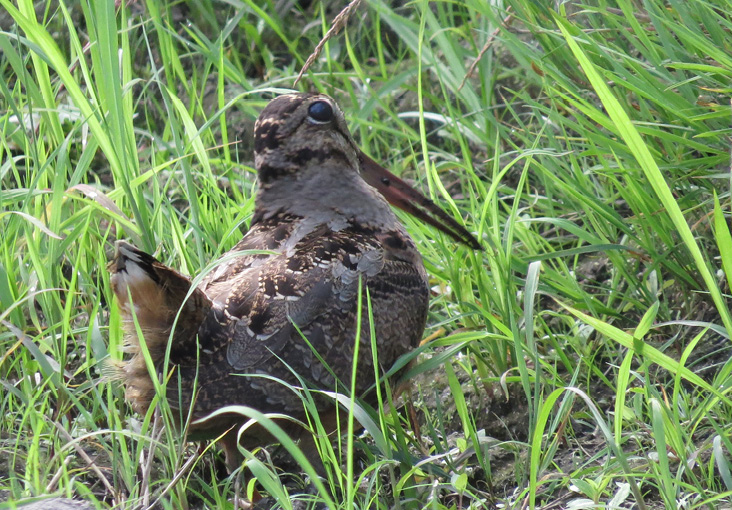
American Woodcocks are regulars in April. All photographs, unless otherwise indicated, by Jay Dia.
Route #1 Meriam's Corner Route
Basics: 1.7 miles round trip, easy terrain
Best: All year
NOTE: This route may be icy in winter
The Meriam's Corner route (Figure 2) is by far the best-known by birders. It travels though several different habitats and offers wonderful opportunities for encountering a rarity. The historical tour signposts along the trail make convenient (and fun) markers for my birding descriptions, so I will make use of them.
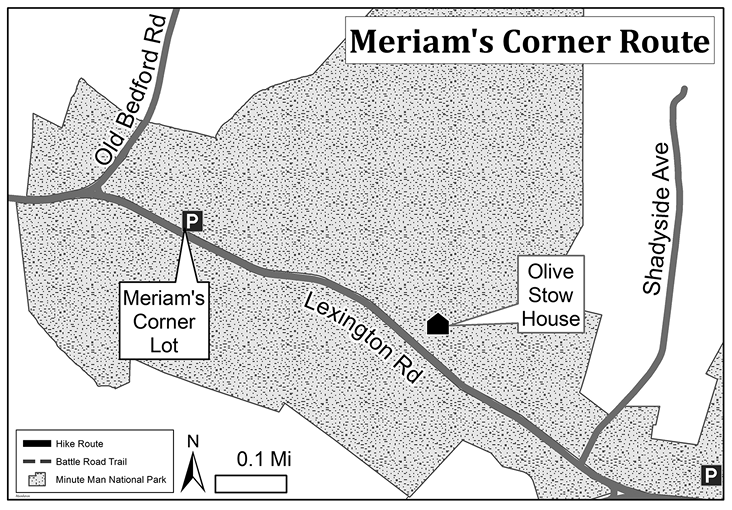
Figure 2. Meriam's Corner Route.
Before you leave the lot, look across Lexington Road to the old Palumbo Farm, recently acquired by Minute Man as the result of a 1968 agreement with the Palumbo family. This area hosts various ducks, swallows, and sparrows. Northern Harrier is a regular visitor and Red-tailed Hawks nest here, their giant young squawking from utility poles in the spring. For details on birding this area, see the "Other Birding Spots in the Park" section below.
From the Meriam's Corner lot you will find the wide trail on the lot's east side beginning at a short bridge. As you walk this circuitous route through varied terrain, pause to imagine the string of battles between the outnumbered British regulars and the colonial militia that took place along this Battle Road on April 19, 1775, and began here in Meriam's Corner. At the time most of this area was cleared for agriculture, and the colonists sought to "…attack and annoy the enemy from behind trees, rocks, fences and buildings, as seemed most convenient…" (Ripley 1832, p. 22-3).
Pre-dawn near the lot, the calls of Great Horned Owls can often be heard from several directions. From late March to mid-April the fields surrounding the lot are a sure bet for finding American Woodcocks. They will begin to peent about 20 minutes after sunset, and their courtship display flight can be heard and sometimes seen without going more than a few steps from your car. For cushy birding bring a lawn chair and a (non-alcoholic) drink.
As you begin down the trail, check the bushes on your left for warblers on migration and sparrows year round. Before the snow is deep White-throated Sparrows dig in the leaf litter in brushy areas all along this trail, and Fox Sparrow is a possibility among them. The fields on the right and ahead often hold Savannah Sparrows in spring.
At Signpost #2 (350 feet from lot) there is a small wetland on your left. Yellow Warbler and Willow Flycatcher nest here. Kingfishers can often be seen flying toward Elm Brook, and Green Herons are often seen in summer. Check for blackbirds in the dead trees, including occasional Rusty Blackbirds in late fall.
From here the trail continues between fields on the left and wooded edges on the right toward Signpost #3 (0.1 miles from lot). In summer the wooded edges are busy with feeding young of common species, and in winter with feeding flocks that often include Golden-crowned Kinglets.
A short distance ahead you will be in woods on both sides of the trail. American Crows have nested in this section of woods each of the last two years, and their loud family vocalizations before and after the young fledge are hard to miss.
Near Signpost # 4 (0.3 miles from lot) you will emerge into a fence-lined grassy area. At the woods' edge the bee-buzz of Blue-winged Warblers can be heard in spring. Bluewings nest in these brushy areas, especially spots that are slightly wet, throughout the park. Watch the tall trees on your left for warblers and gnatcatchers, and less commonly Orchard Orioles and Indigo Buntings in spring. Check the bittersweet vines on your right for feeding warblers even into early winter. I have seen Lincoln Sparrow on the fence line here in fall. Red-tailed Hawks and accipiters frequent the area. Last year in this area I watched a Sharp-shinned Hawk attack a surprised Hairy Woodpecker, which managed to get away pik!-ing indignantly for minutes afterward. Note that Signpost #5 is missing.
Just after a short wooden culvert bridge you will come to large open agricultural fields on your right and left. This is one of the best areas in the park for birding, and in particular for rarity hunting. In the evening in early April Wilson's Snipe roost in the plowed field edges and can often be seen in large numbers camouflaged in the plow ruts if one takes the time to look carefully. Flooded fields can bring sandpipers, including Pectoral, Spotted, and Solitary. During fall migration I have seen as many as 50 Yellow-rumped Warblers feeding on the low plants in the field on the right. Rarities, including Orange-Crowned Warbler, Lark Sparrow, Vesper Sparrow, and Dickcissel, have all been reported here.
At Signpost #6 (0.5 miles from lot) the trail takes a 90-degree right turn. If you continue straight instead of taking the turn you will shortly be on Kaveski Farm Conservation Land. Note that this trail may be muddy and involves a wet crossing. Hands down one of the best birding spots in the area, this detour is always worth your time. The fields adjoining Minute Man NHP and Kaveski Farm can hold many surprises. Raptors, including Cooper's and Sharp-shinned hawk, and less commonly American Kestrel, Merlin, Peregrine Falcon, and Red-shouldered Hawk, are all regulars here, particularly in fall.
Back on the trail, after you turn the corner you will have a grassy field on your left, which hosts bluebirds and finches year-round and the occasional Eastern Meadowlark in spring. On your right, check the agricultural fields in fall and spring for Killdeer and look for American Pipits and flocks of Horned Larks in fall and winter. Glossy Ibis were brief but welcome visitors in April of 2015 and 2017.
Ahead is the present-day Carty Farm and site of the historic Olive Stow Farm. Here in 1775 the 48-year-old widow Stow lived and managed the farm with her two teenage children — no easy feat for a woman of her time. Look in the trees near the brushy edges and farm for Indigo Bunting and Eastern Phoebe. In late spring this is the spot for perhaps the most predictable Alder Flycatcher in Concord. I have seen it in these trees and heard it in the brushy area as well. Alders are present late May through early June at several locations in the park, and I am hopeful that they are breeding here but as yet do not have direct evidence. Keep in mind that audio confirmation is generally needed for Alder identification as Willow is found in the park as well.
Continue onto the boardwalk checking the low bushes as well as the trees beyond the boardwalk for warblers and flycatchers in spring and fall. When you reach the stone mile marker near the road you have reached the end of this route. From here you can retrace your steps to return to the lot. For a longer outing you can loop back through Kaveski Farm Conservation Land. To do so, turn left at the green farm stand onto Shadyside Lane, and continue approximately 0.5 miles to the Kaveski Farm entrance. The main trail through Kaveski Farm will take you back to Minute Man. Alternately, you can cross Shadyside Lane and continue along the sidewalk to Route #2 below.
Route #2 Brooks Farm Boardwalk Route
Basics: 1.5 miles round trip, easy
Best: Spring, summer; sections in winter
The Brooks Farm Boardwalk route (Figure 3) is a pretty trail through various habitats, particularly great for an evening birding outing and worth braving the runners and cyclists you will encounter. I have not birded this route much in fall, so you may have unexpected surprises, particularly near the stream at the end of the boardwalk. Species listed are present spring or summer unless otherwise noted.
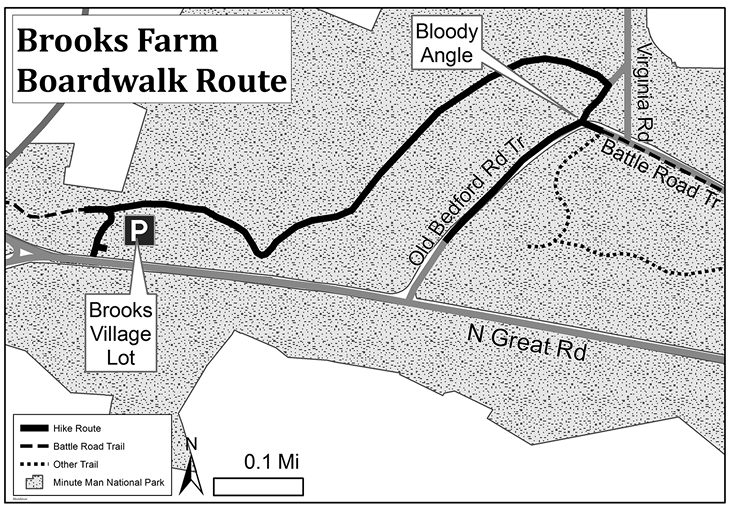
Figure 3. Brooks Farm Boardwalk Route.
This route begins in the Brooks Farm lot on Route 2A in Lincoln just east of its intersection with Lexington Road. In 1775 this area included multiple homes belonging to the Brooks in a sort of family village with businesses, including a tannery, slaughterhouse, brick kiln, and later a tavern complete with a ballroom on the second floor.
Take a moment before leaving the lot to look across the street to the pasture where the impressive-looking Highland Cross and Randall Lineback cattle graze. Look for swallows in season, and Wild Turkeys and various hawks all year. Bluebirds and finches fly among the trees and historic ruins in the open areas near the lot, and there is often a Mockingbird singing from the lamppost or bushes of the historic Job Brooks house. Sapsucker is possible here in winter.
From the lot take the main trail to the T intersection. Take a left for a 150-foot quick detour to check the dead trees for Pileated and other woodpeckers. Returning to the intersection, continue on straight, checking the brush on your left for the many nesting catbirds, as well as American Redstarts, which occasionally nest here.
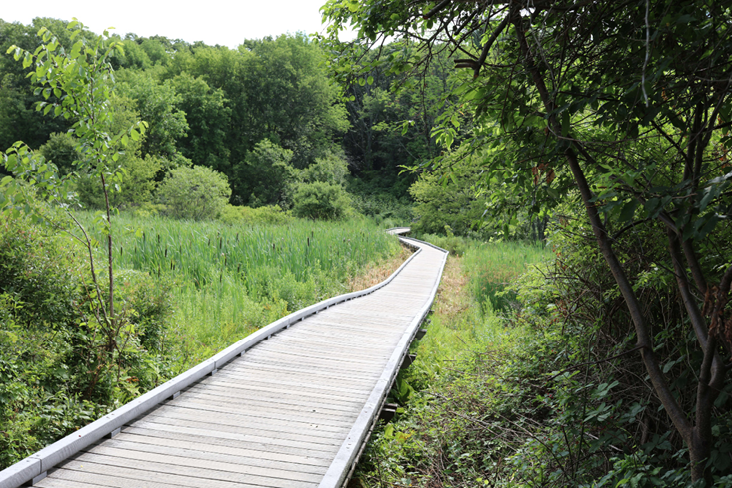
Elm Brook Boardwalk. Photograph by Minute Man National Historical Park.
As you head into the marsh and onto the boardwalk (0.3 miles from lot) look for waxwings, orioles, grosbeaks, Yellow Warblers, and Common Yellowthroats. Check the bare tree tops and listen for woodpeckers and hawks in all seasons and for flycatchers in late spring and early summer. Alder Flycatcher is a regular at this location in the evening in late May and early June, and in May 2016 my husband and I observed an Olive-sided Flycatcher here. In early summer watch for feeding Common Nighthawks.
The stream at the end of the boardwalk attracts birds coming in for a drink. Here the trail takes a left into a wooded habitat where various woodpeckers nest. Just after entering the woods you will came to a large rock on your left. Stop here and look toward Elm Brook for swallows, blackbirds, and herons. A scope is helpful at this location. In winter this is a good place to observe White-throated Sparrows, Golden-crowned Kinglets, and other songbirds coming in and out of the bushes.
Continue into the woods, looking for Hermit Thrushes scurrying among the fallen logs, and in the evening listening for the sounds of the Wood Thrush. Ascending a gentle slope you will come to a low stone wall. Keep in mind that any area where you see a stone wall was likely cleared of vegetation for agriculture at one time.
As you emerge from the woods you will be in the historic Bloody Angle (0.6 miles from lot). Here on April 19, 1775, British regulars were fired on from all directions in a battle in which 30 regulars and four colonial militia men were killed. Perhaps with poetic justice, the Bloody Angle teems with new life each spring and summer. Around 7:00 pm on early June evenings male Indigo Buntings begin advertising from very visible perches in the trees of the open area. Their numbers have decreased over the past five years, but I am hopeful that this is not a permanent trend. As in all of the brushy edges of the park, especially slightly wet edges, listen for nesting Blue-winged Warblers. Other nesting species here include Eastern Wood-Pewee, Great Crested Flycatcher, Rose-breasted Grosbeak, and omnipresent Chipping Sparrow. Turkeys roost for the night in the tall trees of the wooded edges, their awkwardly oversized young balancing on narrow branches.
In mid-July to early August the low bushes and vines that edge the Bloody Angle are alive with feeding bird families. Stand for a spell and see what emerges: orioles, tanagers, gnatcatchers, grosbeaks, buntings, and occasional warblers. Watch for Ruby-throated Hummingbirds feeding on the trumpet vines that wind up the trees where the trail bends sharply right.
Shortly you will come to another T intersection. Turn right onto Battle Road, and continue to the grave of unnamed British soldiers. Looking down the left path you will see a stone marker on the right indicating the end of the Vernal Pool Trail. If time allows, take a detour down part or all of this wonderful trail (described in Route #3 description, but keep in mind you will be approaching it in reverse). If not, continue straight ahead with the wooden fence line on your right. Here you will have the edge of the Vernal Pool area on your left where Scarlet Tanager, Northern Waterthrush, and various thrushes, including Veery are dependably heard.
Retrace your steps to return to the lot. As you pass the edge of the Bloody Angle and begin to enter the woods, look over the hillside. This is Brooks Hill, which colonists climbed to lie in wait for the British. On a peaceful day this view can bring a great appreciation for the natural beauty here and a reverence for the pivotal events that took place where you now stand.
Route #3: Hartwell/Vernal Pool Loop
Basics: 1.2 miles: Vernal Pool Trail is uneven muddy terrain, other portions are easy. Insect repellant is suggested.
Best: Spring, early summer; sections in fall and winter
The Hartwell/Vernal Pool loop (Figure 4) is an under-appreciated birding hot spot that is rich with migrants in spring and some wonderful nesting species in summer. In fall the brushy trail behind the tavern is worth a look. In winter, check the cone trees at the start of the Vernal Pool Trail and open areas and tall trees lining Battle Road and surrounding the Hartwell Tavern.
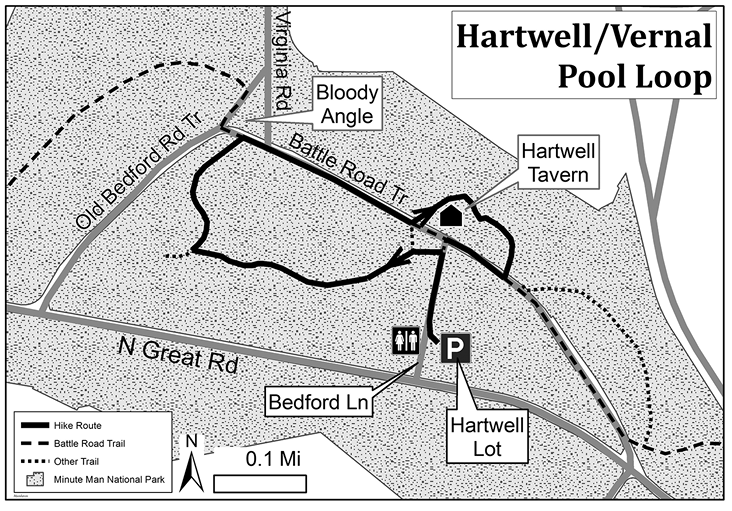
Figure 4. Hartwell/Vernal Pool Loop.
This loop begins at the Hartwell Tavern lot on Route 2A in Lincoln, just west of Hanscom Drive. Don't rush to leave the lot as some of your best sightings may be here. In spring warblers, often including Blackburnian, and vireos abound in the treed lot.
From the lot head down the wide main trail, named Bedford Lane. A stop at the restrooms on your left is worthwhile first for the obvious reason—it's among the nicer of birding bathrooms—and second, and more importantly, because Scarlet Tanagers and Baltimore Orioles often nest nearby in June. Look for the intricate sac-like oriole nests in the open treed areas and tanager nests in the more densely wooded areas. Listen for Prairie Warblers singing near the road in late May.
As you continue on the wide main trail check the bushes on the right for migrants and residents. This is where, on an eight-flycatcher-species day at the park in late spring, I observed both Yellow-bellied and Olive-sided flycatchers. In early spring Veeries may be seen hopping on and along the low rock walls ahead.
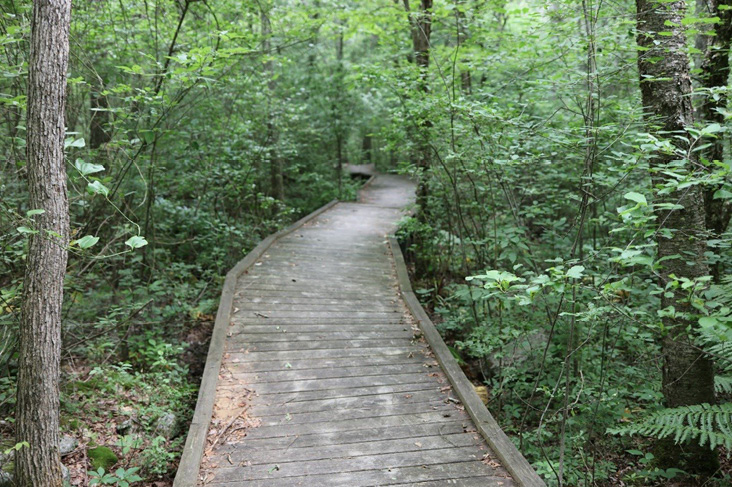
Vernal Pool Trail.
About 350 feet down the main trail you will find a sign for the entrance to the Vernal Pool Trail on your left. You will often have this quiet trail to yourself as you bird. Before entering the woods, the trail moves through a transitional habitat where you can find many migrating warblers in spring and nesting species in summer, including Rose-breasted Grosbeak, American Redstart, Blue-winged Warbler, and Blue-gray Gnatcatcher. There are tall conifers in this open area that attract feeding birds to their cones in winter and are worth a look in irruption years for winter specialties.
Entering the woods and wetland habitat, look and listen for thrushes in spring and summer: Swainson's and Hermit on migration, and Wood and Veery nesting. Northern Waterthrush, Ovenbird, Scarlet Tanager, and Pileated Woodpecker are all nesting species here, and Brown Creepers can be heard year-round. At the T intersection (0.4 miles from lot) ignore the sign with the left-pointing arrow, and turn right to follow the boardwalk, watching carefully in the low wet areas for camouflaged ground-feeders.
On emerging from the woods you will be on Battle Road (0.5 miles from lot). A left turn takes you to the Bloody Angle described in Route #2 above. I recommend taking a 20-minute or so detour to this historic and very birdy area, then returning to Battle Road.
Returning to the Vernal Pool Trail's end where you emerged, continue on Battle Road. This will be a right turn if you skipped the Bloody Angle detour. In spring check the tall trees bordering the trail for warblers and nesting gnatcatchers. In winter feeding flocks are active in the branches.
Continuing on, you will pass grassland areas with small trees on your left where in June you can see numerous Baltimore Oriole nests and Wild Turkeys wading through the grass with their young. In winter check the tall trees around the tavern for bluebirds, waxwings, and a possible sapsucker. In 2017 a pair of Yellow-billed Cuckoos stayed in the wooded area opposite the tavern all summer, and although I could not locate their nest, their continuous presence from late May to late June makes breeding likely.
Shortly you will arrive at Hartwell Tavern (0.7 mile from lot) on the left. Here Ephraim and Elizabeth Hartwell ran part of their home as an inn. If the Tavern is open you can take a non-birding pause to tour the beautifully restored interior, join a ranger-led walk, or perhaps watch a musket shooting demonstration.
Walk behind the tavern's right side to the wooden fence line (0.8 mile from lot). You will find that there is a rough trail that follows the fence line on the opposite side from the tavern. During spring migration there are always many warblers, kinglets, and vireos along this short trail, often including Tennessee. Accipiters hunt here in all seasons. You can exit this trail by retracing your steps to Hartwell Tavern or, if the trail is passable, continue on to the Smith House sign (0.9 mile from lot) and turn right. This will take you back to Battle Road. Turn right here to return to the tavern. Do be sure to check for ticks upon your return to the tavern and please respect private properties below the trail. Head back to the lot on Bedford Lane opposite the tavern.
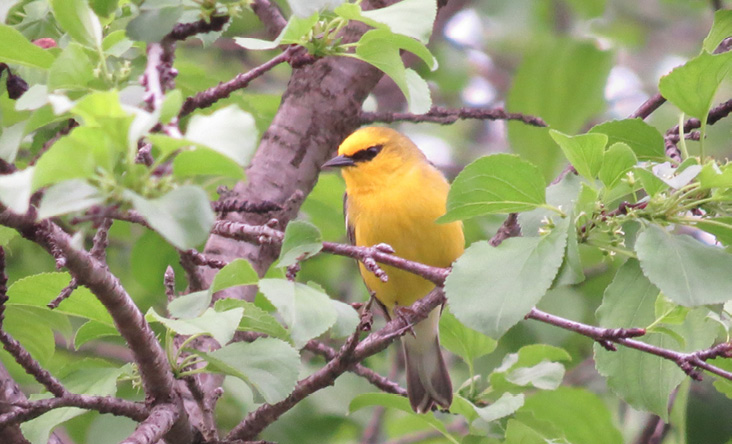
Blue-winged Warblers nest throughout the NHP.
Other Birding Spots in the Park (East To West)
Fiske Hill is accessed from the eastern-most lot in the park on Old Massachusetts Avenue just off Route 2A in Lexington. It is a lovely walk to the top of the hill. Invasive plant removal is planned for this area, and the rock outcrop's open grassy top may turn out to be a new hot spot for nesting species… stay tuned.
Battle Road Visitor Center on Route 2A has a small pond that hosts various species, particularly in the colder months when the pond remains unfrozen for a while. Check the low, wet, brushy areas along the side of the lot for interesting sparrows any time of year.
Dirt Road Fen is a small but special wetland down a dirt road across Lexington Road from the Meriam's Corner area. This is a unique habitat, attracting migrants in the spring, and some special nesting species, including Ovenbird, Veery, and Northern Waterthrush. Note that although the wetland is Minute Man NHP property, the road itself is private. The owners are gracious to birders, but please be respectful by stopping at the National Park Service boundary sign. An artist friend of the owner has created found-art sculpture all along the road. Please use caution on Lexington Road.
Palumbo Farm Conservation Land is a grassland across Lexington Road from Meriam's Corner. Park officials do not mind if birders walk along the old road edging this field; enter where you see the chain and "No public access" sign. However, the park asks that birders please stay clear of the old farm buildings. This area hosts various swallows, ducks, flocks of turkeys, and raptors including Northern Harrier. Skirting the buildings as best you can, check the back corners of the field for sparrows. Please use caution on Lexington Road.
The Old North Bridge is a historical must if you have never visited the Minute Man NHP. While you are brushing up on your Revolutionary War history, check the lot across the street and the brushy river edges for migrants. The tall oaks along the path host bluebirds, orioles, woodpeckers, and gnatcatchers in spring and possible sapsuckers in winter.
Future Conservation Efforts and eBird Data
On a closing note, I have been enthused by how interested park officials have been in survey findings, eBird data, and in protecting wildlife and their habitats within the park. Over the next couple years I will be working with the park on creating a printed and PDF bird checklist for park visitors, adding some bird walks to the park's wonderful variety of public programs, and compiling some suggestions for simple bird conservation strategies. Your eBird submissions will be helpful in these efforts. If you have personal eBird locations within the park, consider merging them to one of the two eBird hotspots with the park so that your data will be included in these efforts.
Meriam's Corner: http://ebird.org/ebird/hotspot/L858741
Minute Man National Historical Park: http://ebird.org/ebird/hotspot/L941919
I hope that you will enjoy birding at Minute Man NHP and I look forward to hearing what you find!
Acknowledgements
Many thanks to Margie Coffin Brown, director of Cultural and Natural Resources at Minute Man NHP for her time and interest, and for the use of park photos and historical materials. Thanks to Cherrie Corey and David Swain for editing assistance; to Jason Forbes for edits and lending his own inside knowledge of the park; and to all of the birders who have contributed eBird data used for this article. Lastly thanks to my husband Jay for assistance with mapping apps and GPS, walking companionship, and patience.
Resources
- Dietrich-Smith, D. and Olmsted Center for Landscape Preservation 2005. Cultural Landscape Report for the Battle Road Unit, Minute Man National Historical Park, Vol. 1. Brookline, Massachusetts: National Park Service Olmsted Center for Landscape Preservation.
- Minute Man National Historic Park website: www.nps.gov/MIMA
- Ripley, E., with other citizens of Concord. 1832. A History of the Fight at Concord on 19th of April 1775. Concord, Massachusetts: H. Atwill.
- Ryan, D. Michael. 2005. Noah Brooks Tavern at http://lincolnminutemen.org/history/articles/ryan_brooks_tavern.html
- Yocum, B. A. 2004. Meriam House Minute Man National Historical Park, Concord, Massachusetts Historic Structure Report. Lowell, Massachusetts: National Park Service.
Kathy Stark Dia is a former professional ballet dancer who now teaches ballet in Acton, Massachusetts. She grew up in Pittsburgh in a family who enjoyed nature but came to birdwatching later in life. After leaving a full-time position at an arts high school, she began working part-time for Mass Audubon Broadmoor, where she leads school field trips and adult bird walks. Kathy volunteers for Minute Man NHP, Vermont Center for Ecostudies, Brookline Bird Club, and at Great Meadows National Wildlife Refuge.